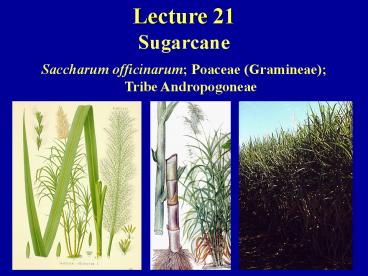Lecture 21 Sugarcane - PowerPoint PPT Presentation
1 / 35
Title: Lecture 21 Sugarcane
1
Lecture 21Sugarcane
Saccharum officinarum Poaceae (Gramineae) Tribe
Andropogoneae
2
Honey
Hunter of bees, Arana, Spain 7000 BCE
Bee in Ancient Egypt
3
Sweet Sap from Sugar Palm and Maple
Collection of sapfrom sugar palm
Collection of sap from sugar maple and
evaporation in North America
4
Ancient Sugar Mill Hawaii Sugar planters
Research Institute
5
Sugar (sucrose) from sugarcane is the cheapest
energy food. Sugarcane is the most important
source of sugar followed by sugar beet. Generally
sugarcane is a crop of the humid tropical
lowlands, but does best in wet and dry
tropics. Some still grown in Southern Europe and
United States (Hawaii, Louisiana,
Florida). Hawaii is now going out of the sugar
business. Per capita consumption is very high in
the United States, Europe, and English speaking
countries in general.
6
History Sugarcane cultivated in India in 400
BCE. The art of sugarcane cultivation was carried
from India to China as well as to Arabia and to
Europe during the Crusades. Southern Europe
provided the world market during the Middle
Ages. Sugarcane introduced to Madeira and Azores
in 1420. Columbus took sugar to the New World in
1493. In 1791 Capt. Bligh (Mutiny on the Bounty
fame) transported varieties of S. officinarum
from Tahiti to Jamaica previous cultivation was
the thin stalkedS. sinsense and S. barberi
native to Bay of Bengal.
7
S. officinarum is probably native to the South
Pacific (New Guinea) and is very tall known as
noble canes (There is no sugar industry there but
canes are grown for chewing). The thick-stemmed
types were successful in all sugar growing
areas. However, with outbreaks of diseases and
pests, breeding programs were developed and the
pedigrees of modern cultivars are now very
complex. 19th century Rise of beet sugar. 20th
century Corn sweeteners synthetic sweeteners.
8
(No Transcript)
9
(No Transcript)
10
Botany Saccharum species S. officinarum
(2n80)Thick-stemmed (noble) canes from New
Guinea S. sinense (2n118)Thin-stemmed hardy
canes from China S. barberi (2nvariable)Thin-s
temmed hardy canes from India S.
spontaniumWild canes of SE Asia important in
breeding S. robustrumDeeply penetrating roots,
disease and drought resistant
11
Morphology of Setts Bud, Secondary shoot, Leaf
scar, Root primordia
12
Breeding Crosses made by cutting inflorescence
and placing shoot in water or dilute nutrient
solution seeds will set and mature on these cut
shoots. Breeding has been very important in
increasing yields especially Nobilization, the
incorporation ofS. officinarum. In Java, yields
per hectare were 1 t in 1840, 10 t in 1910, 20 t
in 1940 and 32 t in l952. Yields of cane and
sugar content continues to increase.
13
Meteorological Inst. Hawaii Sugar planters
Research Inst.
14
Sugar Seedlings Hawaii Sugar Planters Research
Institute
15
Culture Usually planted as a perennial crop but
can also be grown as an annual. Asexually
propagated by stem cuttings (setts) planted in
furrows. Rows are 3 to 8 feet wide. Flowering can
be prevented with diquat. Planted in wet seasons,
harvested in dry season.
16
Harvest Harvested when sugar content is as at a
maximum. Needs a dry period to arrest growth to
accumulate sugar. Flowering is not necessarily a
sign of maximum sugar content. Once harvested it
needs to be processed within 48 hr. In many
countries two year old fields are cut but
generally the cycle is 1218 months. Harvest is
traditionally by hand cutting (removing top and
trash with a machete) but now is often machine
harvested (Hawaii). Burning may be carried out to
remove trash but this must be carefully done to
avoid uncontrolled fires.
17
Sugar Manufacture
Extraction of sugar in Sicily, 1584
Production of sugarin Venice
18
Manufacture of Cane Sugar Extract juice by
crushing Water added Re-crush Bagasse, canes
after crushing, can be used as fuel Raw juice
(sugars nonsugars (dissolved solids) water)
Heated lime (causes separation of insolubles),
settled in clarifiers
19
Successive boiling to concentrate. (Produces a
dark hygroscopic material called gur in India,
jaggery in Africa, panela in Latin America,
rapadura in Brazil) Filter (vacuum pan
Centrifuged to crystallize sugar) Decolorized
with carbon black Drying, screening Residue
molasses 35 sucrose 15 reducing sugars
(glucose and fructose) Distilled to produce rum
(colorless), alcoholic spirit
20
Manufacture of Cane Sugar Extract juice by
crushing Water added Re-crush Bagasse (used as
fuel) Raw juice is heated Lime added, causing
separation Insolubles settle in
clarifiers Successive boiling to
concentrate Filter (vacuum pan) Centrifuged to
crystallize sugar Decolorized Drying,
screening Residue molasses35 sucrose15
reducing sugars Distilled to produce rum
21
Sugarcane, Nerja, Spain, 1972
22
Loading Sugarcane, Fodder on Donkey, Nerja,
Spain, 1972
23
Field of Sugar Cane, Sao Paulo 1965
24
Sugarcane harvest, Puerto Rico, 1972
25
Mechanical loading of Sugar Cane, Puerto Rico,
1963
26
Sugar Mill, Ponte Nova, Brazil, 1963
27
Sugar Mill, Ponte Nova, Brazil, 1963
28
Sugar Mill, Ponte Nova, Brazil, 1963
29
Sugar Mill, Ponte Nova, Brazil, 1963
30
Sugar Mill, Ponte Nova, Brazil, 1963
31
Sugar Mill, Ponte Nova, Brazil, 1963
32
(No Transcript)
33
Loading sugarcane, Maui, Hawaii
34
Sugar refinery, Ewa plantation, Hawaii
35
Sugar refinery, Ewa plantation, Hawaii































